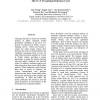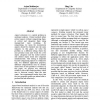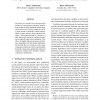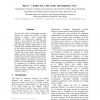AAAI
2012
12 years 7 months ago
2012
Twitter sentiment analysis (TSA) has become a hot research topic in recent years. The goal of this task is to discover the attitude or opinion of the tweets, which is typically fo...
ACL
2012
12 years 7 months ago
2012
This paper describes a system for real-time analysis of public sentiment toward presidential candidates in the 2012 U.S. election as expressed on Twitter, a microblogging service....
ACL
2012
12 years 7 months ago
2012
Aspect extraction is a central problem in sentiment analysis. Current methods either extract aspects without categorizing them, or extract and categorize them using unsupervised t...
ACL
2012
12 years 7 months ago
2012
In this paper, we present a structural learning model for joint sentiment classification and aspect analysis of text at various levels of granularity. Our model aims to identify ...
ACL
2012
12 years 7 months ago
2012
Polarity classification of words is important for applications such as Opinion Mining and Sentiment Analysis. A number of sentiment word/sense dictionaries have been manually or ...
EMNLP
2011
13 years 4 months ago
2011
We present a general learning-based approach for phrase-level sentiment analysis that adopts an ordinal sentiment scale and is explicitly compositional in nature. Thus, we can mod...
JCDL
2011
ACM
13 years 7 months ago
2011
ACM
With product reviews growing in depth and becoming more numerous, it is growing challenge to acquire a comprehensive understanding of their contents, for both customers and produc...
ACL
2011
13 years 8 months ago
2011
We derive two variants of a semi-supervised model for fine-grained sentiment analysis. Both models leverage abundant natural supervision in the form of review ratings, as well as...
ACL
2011
13 years 8 months ago
2011
Most previous work on multilingual sentiment analysis has focused on methods to adapt sentiment resources from resource-rich languages to resource-poor languages. We present a nov...
125
click to vote
WWW
2011
ACM
13 years 11 months ago
2011
ACM
The explosion of Web opinion data has made essential the need for automatic tools to analyze and understand people’s sentiments toward different topics. In most sentiment analy...




